Introduction:
Nestled in the heart of Rajasthan India, Udaipur stands as a jewel in India’s crown, captivating travelers with its regal charm and mesmerizing beauty. This enchanting city boasts a plethora of historic sites, serene lakes, and architectural wonders that together create an unforgettable travel experience. In this comprehensive guide, we will delve into the top 7 must-visit places in Udaipur, each offering a unique glimpse into the city’s rich cultural heritage and stunning landscapes.
“Explore the regal charm of Udaipur in Udaipur Travel Guide! Discover the top attractions, including City Palace, Lake Pichola, Jagdish Temple, and more. Immerse yourself in the city’s rich heritage and serene lakes, making your trip truly unforgettable.”
City Palace Udaipur: Where Royalty Meets Architectural Grandeur
The City Palace in Udaipur stands as an iconic testament to the grandeur and elegance of the Mewar dynasty. Perched on the eastern banks of Lake Pichola, this majestic palace complex is a living embodiment of the city’s rich history, artistic finesse, and royal legacy. As you step into its opulent courtyards and intricate chambers, you’re transported to an era of regal splendor and architectural brilliance.
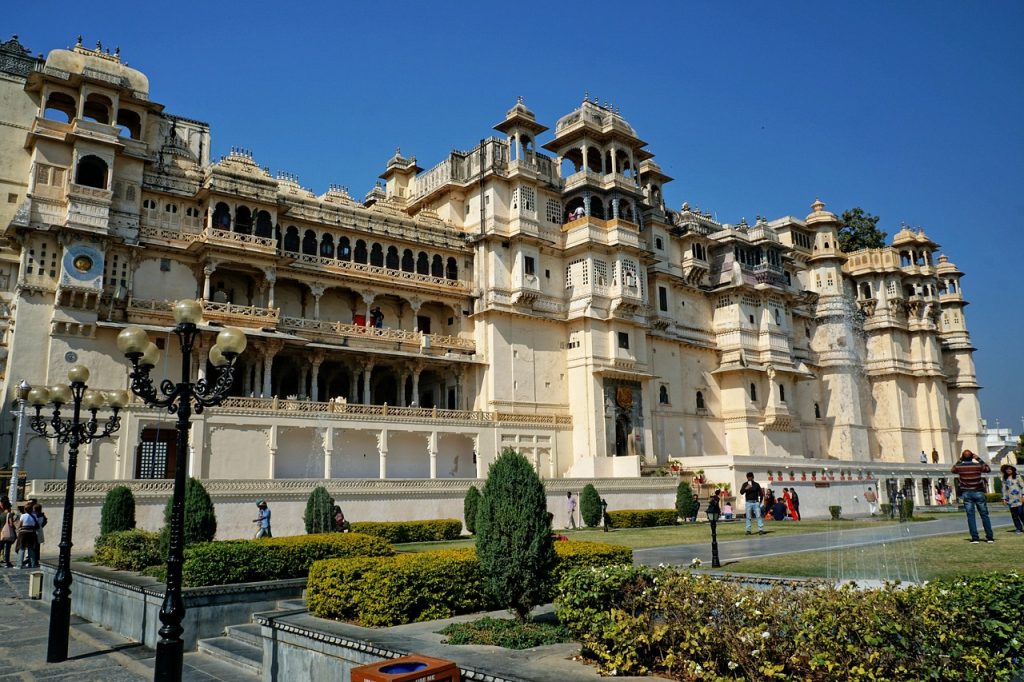
Architectural Marvel:
The City Palace is an architectural fusion, blending Rajasthani and Mughal styles with European influences. The complex is a breathtaking panorama of domes, turrets, arches, and ornate decorations, each element meticulously crafted to create a harmonious whole. Its sheer size and intricate detailing reflect the artistic sensibilities and craftsmanship of the artisans who brought it to life.
Palace Complex Highlights:
Courtyards and Galleries:
The palace is divided into several courtyards, each with its unique character. The Badi Pol (Great Gate) welcomes visitors into the first courtyard, and the Tripolia Gate leads to the central courtyard, where you’ll find the elegant Mor Chowk with its exquisite peacock mosaics. The Chini Chitrashala showcases an array of Chinese and Dutch ornamental tiles, adding an international touch to the palace’s decor.
Crystal Gallery:
Next in Udaipur Travel Guide is one of the standout attractions within the City Palace is the Crystal Gallery, housing a stunning collection of crystal artifacts and furniture. Among its prized possessions are a crystal Maharana’s Throne, crystal chandeliers, and rare glassware that narrate tales of luxury and refinement.
Museum and Artifacts:
The City Palace Museum is a treasure trove of historical artifacts, showcasing the personal belongings of the Maharanas, including weapons, armor, textiles, and artworks. The museum’s galleries offer insights into the royal lifestyle, ceremonial costumes, and the evolution of Udaipur’s cultural heritage.
Sheesh Mahal:
The Sheesh Mahal, or Mirror Palace, is an ethereal chamber adorned with intricate mirror work and glass mosaics. As light plays upon the surfaces, the entire room seems to come alive with a myriad of reflections, creating an enchanting visual spectacle.
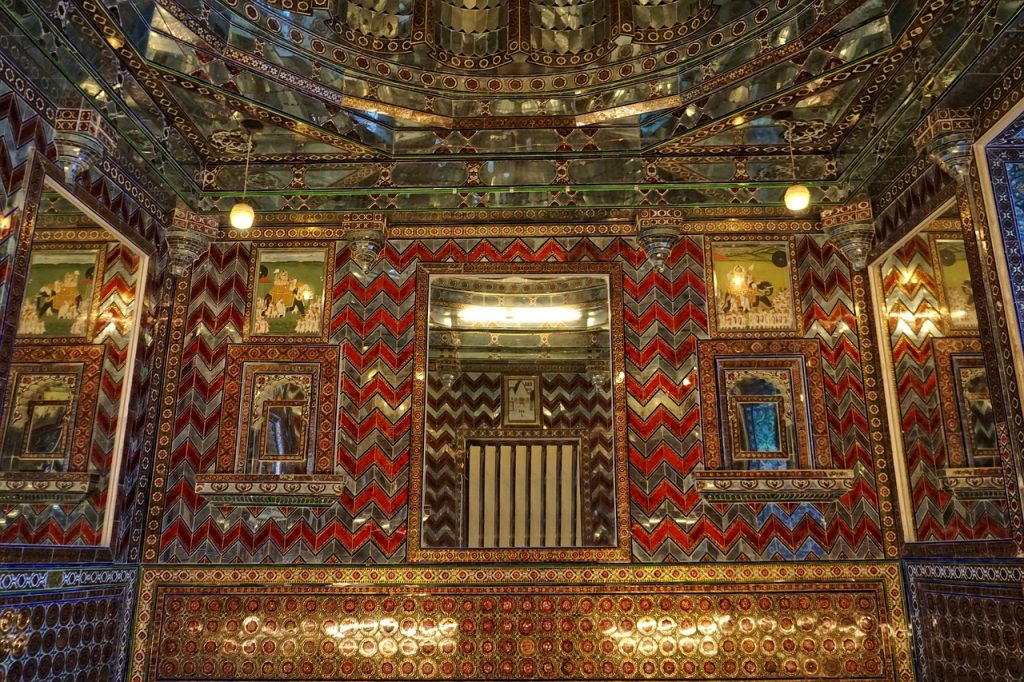
Panoramic Lake Views:
One of the most enchanting aspects of the City Palace is its strategic location overlooking Lake Pichola. The terraces and balconies offer panoramic views of the lake, the island palaces, and the surrounding Aravalli hills. The vista becomes particularly magical during sunset when the sky is painted in hues of gold and the lake mirrors the captivating scene.
Cultural Events and Hospitality:
The City Palace also serves as a backdrop for various cultural events, including traditional performances, concerts, and celebrations. Its majestic backdrop lends an air of elegance to any event hosted within its premises. Additionally, a part of the palace has been converted into a luxury hotel, allowing guests to experience the regal lifestyle firsthand.
Preserving History and Heritage:
The City Palace isn’t merely a tourist attraction; it’s a living heritage that continues to be preserved by the royal family of Udaipur. The palace complex serves as a tangible link to the city’s past, a repository of stories, traditions, and artistic achievements that have shaped Udaipur’s identity.
conclusion:
In Udaipur Travel Guide the City Palace of Udaipur is a captivating journey through time, a place where the opulence of the past intertwines with the artistic prowess of the present. It offers an immersive experience of the royal lifestyle, architectural finesse, and cultural legacy of Udaipur. A visit to the City Palace is more than a tour; it’s a voyage into the heart of Rajasthan’s regal history.
Lake Pichola: Where Tranquility and History Dance on Rippling Waters
Lake Pichola, the crown jewel of Udaipur’s landscape, is a picturesque masterpiece that enchants visitors with its serene waters, historic islands, and the reflection of centuries-old palaces. This artificial lake, created in the 14th century, is not just a body of water; it’s a living canvas that narrates the tale of Udaipur’s evolution, culture, and romance.
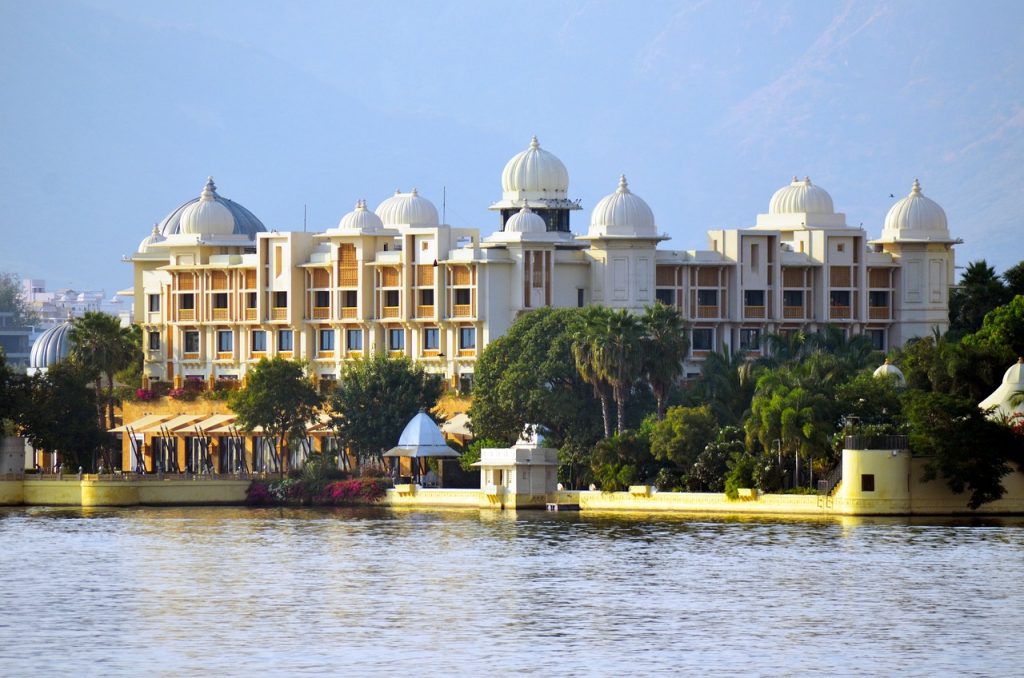
Sculpted by History:
Lake Pichola’s origin story dates back to the time of Maharana Udai Singh II, the founder of Udaipur. To secure his kingdom against external threats, the Maharana built this lake by damming a river stream, transforming the landscape into a tranquil oasis that embraced the city. Over the centuries, the lake’s magnificence was further enhanced by the addition of several islands and architectural marvels.
Lake Palace:
Perhaps the most iconic image associated with Lake Pichola is the ethereal Lake Palace, also known as Jag Niwas. Rising like a mirage from the lake’s waters, this marble palace seems to float on the surface, creating an illusion of magic and mystery. Originally built as a summer retreat for the royals, the palace now operates as a luxurious hotel, where guests can experience the opulence and elegance of a bygone era.
Jag Mandir Island:
Another island that graces Lake Pichola is Jag Mandir. This island palace, with its intricately carved structures and lush gardens, offers a serene retreat where one can bask in the tranquility of the lake. It’s said that Emperor Shah Jahan found inspiration for the Taj Mahal during his stay on this island, and it’s not difficult to see why – the blend of natural beauty and architectural brilliance is truly inspiring.
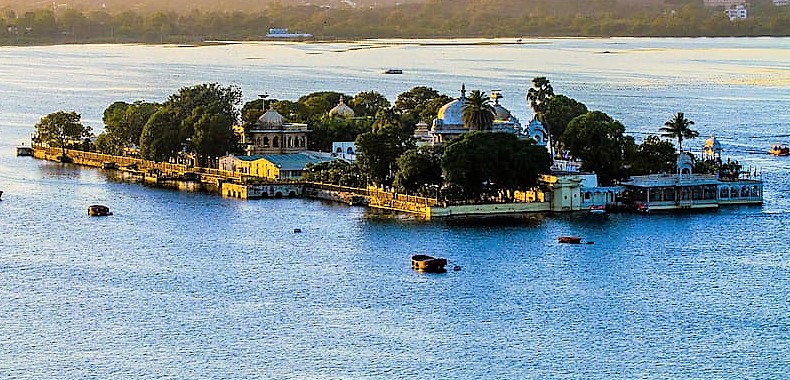
Boat Rides and Panoramic Views:
Exploring Lake Pichola by boat is a mesmerizing experience that allows you to soak in the enchanting beauty from a unique vantage point. As the boat glides through the water, you’ll be treated to breathtaking views of the surrounding hills, the charming Ghats, and the majestic City Palace perched on the shore. The boat ride also provides an intimate glimpse of the intricate details of the island palaces.
Sunset Magic:
While Lake Pichola is a sight to behold at any time of day, it truly comes alive during sunset. As the sun dips below the horizon, the entire lake and its surroundings are bathed in a warm, golden glow. The water sparkles like a sea of jewels, and the palaces and temples on the lakeshore are bathed in a magical light. It’s a moment of sheer enchantment that captivates both the eyes and the soul.
Cultural Connections:
Lake Pichola is not just a scenic spot; it’s deeply intertwined with the cultural fabric of Udaipur. The lake’s banks have been the venue for numerous festivals, events, and celebrations over the centuries. The Gangaur Festival, which celebrates the divine union of Lord Shiva and Goddess Parvati, features a colorful boat procession on the lake, adding a touch of spirituality to the serene waters.
Conclusion: A Timeless Oasis:
Lake Pichola is more than just a body of water; it’s a reflection of Udaipur’s spirit, history, and romance. Its tranquil waters cradle the stories of emperors, the elegance of palaces, and the timeless charm of a city that celebrates its heritage with pride. As you immerse yourself in the allure of Lake Pichola, you become a part of the canvas, a witness to the dance of history and tranquility on its rippling waters.
Jagdish Temple Udaipur: Where Devotion Meets Architectural Brilliance
Nestled in the heart of Udaipur, the Jagdish Temple stands as a symbol of devotion, architectural finesse, and the city’s rich cultural heritage. This majestic Hindu temple, dedicated to Lord Jagannath (a form of Lord Vishnu), has been an integral part of Udaipur’s landscape for centuries, attracting both worshippers and admirers of intricate craftsmanship.
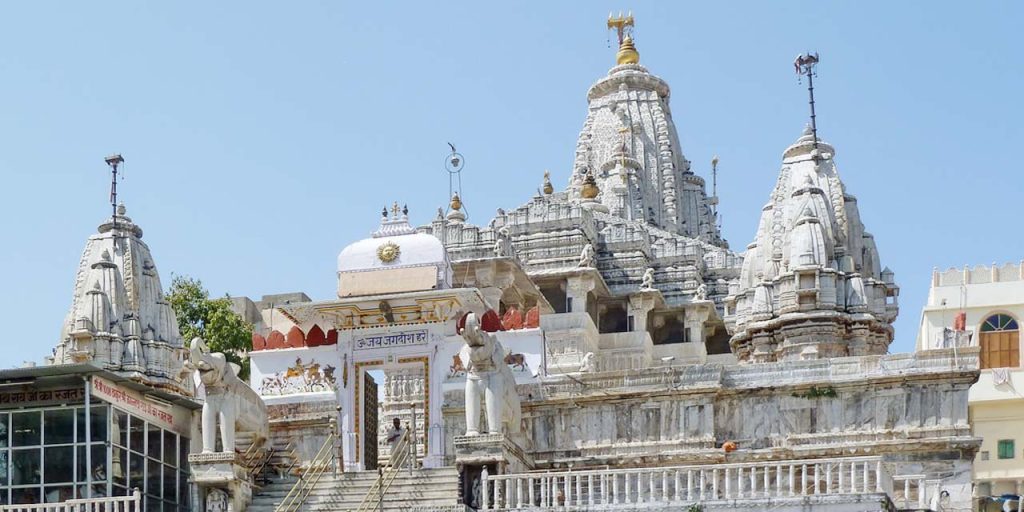
Architectural Marvel:
Built in 1651 by Maharana Jagat Singh I, the temple is a masterpiece of Indo-Aryan architecture. Its towering spire, intricate carvings, and detailed sculptures are a testament to the artistic prowess of the craftsmen of that era. The temple’s structure seamlessly blends the intricacies of ancient Indian architecture with the charm of the Mewar region.
Exquisite Carvings:
The exterior of the temple is adorned with intricate carvings that depict scenes from Hindu mythology, epics like the Ramayana and Mahabharata, and various deities. These stone carvings are a visual treat, showcasing the mastery of the artisans who transformed raw stone into works of art that tell stories and evoke emotions.
Majestic Entrance:
As you approach the temple, you’re greeted by an ornate entrance that leads to a spacious courtyard. The entrance is flanked by stone elephants, and a beautifully sculpted torana (archway) adds a regal touch to the entrance. This grand entrance is a prelude to the captivating beauty that awaits within.
Sanctum and Idol:
The inner sanctum of the temple houses the main idol of Lord Jagannath, carved from a single piece of black stone. The idol’s serene expression and divine presence create an atmosphere of devotion and tranquility. Surrounding the main idol are smaller shrines dedicated to various deities, each with its unique charm and significance.
Mandap and Architecture:
The temple’s mandap (hall) is a sight to behold, with its 50 intricately carved pillars that support the roof. These pillars are adorned with detailed motifs and scenes from Hindu mythology. The mandap’s open design allows natural light to filter in, creating an ambience of spirituality and serenity.
Spiritual Significance:
The Jagdish Temple is not just an architectural wonder; it holds deep spiritual significance for the people of Udaipur. Devotees throng to the temple to offer their prayers and seek blessings from Lord Jagannath. The temple’s serene atmosphere and the soul-stirring chants create an environment where one can connect with their inner self.
Cultural Events:
The temple also plays a role in the city’s cultural landscape. It serves as a venue for various religious ceremonies, festivals, and cultural events. During festivals like Janmashtami and Aarti, the temple becomes a hub of activity, resonating with the sounds of devotional songs and vibrant celebrations.
Preserving Heritage:
The Jagdish Temple isn’t just a place of worship; it’s a living testament to Udaipur’s cultural and architectural legacy. The temple’s preservation over centuries is a testimony to the city’s commitment to honoring its past and ensuring that its architectural treasures remain for generations to come.
Conclusion: A Spiritual and Artistic Gem:
The Jagdish Temple is a microcosm of Udaipur’s essence – a blend of devotion, artistic brilliance, and cultural richness. Its architecture tells the story of a bygone era, while its spiritual aura offers a sanctuary for seekers of solace. As you stand before its majestic façade and explore its intricacies, you’re transported not just to a temple, but to a time and space where devotion and architecture come together in harmonious symphony.
Saheliyon ki Bari: A Serene Oasis of Royalty and Tranquility
In the heart of Udaipur lies a place of captivating beauty and serenity – Saheliyon ki Bari, the Garden of Maidens. This exquisite garden, adorned with lush greenery, enchanting fountains, and marble pavilions, is a testament to the romantic era of the Mewar dynasty. A haven for the women of the royal court, this garden continues to captivate visitors with its charm and the stories it whispers of bygone times.
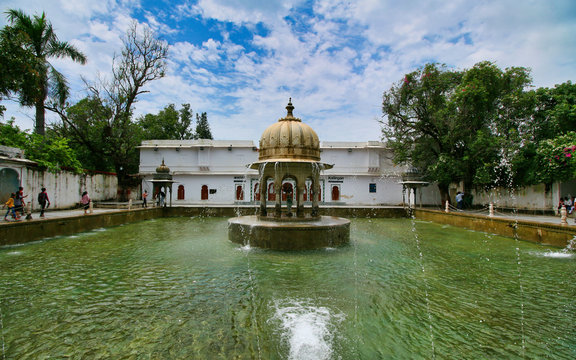
The Royal Retreat:
Built in the 18th century by Maharana Sangram Singh II, Saheliyon ki Bari was conceived as a tranquil escape for the women of the royal household and their attendants. The garden was designed as a place of respite, where the ladies could immerse themselves in the beauty of nature and enjoy moments of leisure away from the hustle and bustle of the palace.
Architectural Splendor:
The architecture of Saheliyon ki Bari is a harmonious blend of Mewar and Rajput styles. The garden features several pavilions, lotus pools, marble kiosks, and ornate fountains that exude an aura of elegance and refinement. Intricately carved marble columns, delicate jharokhas (balconies), and detailed lattice work stand as testimony to the artisan’s dedication to creating a symphony of art and nature.
Lotus Pool and Fountains:
The heart of Saheliyon ki Bari is the lotus pool, surrounded by pavilions adorned with splendid marble sculptures. The lotus pool, with its blooming lotus flowers, adds a touch of tranquility to the garden’s ambiance. The numerous fountains, each unique in design, create a soothing melody as water cascades and sparkles in the sunlight, adding a touch of whimsy to the surroundings.
Courtyard of Delights:
The central courtyard of the garden is adorned with marble elephants, carved out of single blocks of stone. These elephants, in various postures and expressions, symbolize strength, grace, and the close bond shared by the royal women and their attendants. The courtyard serves as a tranquil gathering space where visitors can reflect on the garden’s beauty.
Floral Elegance:
Saheliyon ki Bari is a paradise for botany enthusiasts. The garden boasts a vibrant array of flowers, including roses, marigolds, and bougainvillea, which infuse the air with their intoxicating fragrance. The manicured lawns and carefully tended flower beds are a visual treat that transports visitors to a world of colors and scents.
Cultural Events:
Beyond its architectural splendor, Saheliyon ki Bari is a venue for cultural events and festivals. The garden hosts traditional dance performances, music recitals, and other cultural celebrations that showcase the region’s artistic heritage. These events breathe life into the garden, infusing it with the same vibrancy that must have graced its alleys during the royal era.
Reflections of Royalty:
As you wander through the pathways of Saheliyon ki Bari, you can’t help but feel the echoes of history and the laughter of the royal ladies who once sought solace within its boundaries. The garden’s serene charm and timeless beauty are a testament to the resplendent legacy of the Mewar dynasty and its commitment to creating spaces of joy and tranquility.
Conclusion: An Evergreen Oasis:
Saheliyon ki Bari is more than just a garden; it’s a living testament to the grandeur and grace of a bygone era. Its marble pavilions, lotus-filled pools, and serene ambiance transport visitors to a world of refined elegance. As you explore its nooks and corners, you’ll discover that Saheliyon ki Bari is not just a place – it’s a timeless haven where nature and architecture unite to create an oasis of beauty, respite, and historical charm.
Please Read PART TWO HERE
You can Calculate Your EMI HERE

